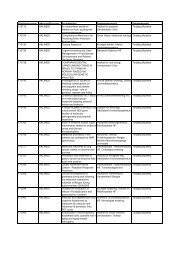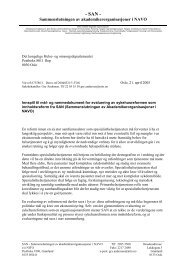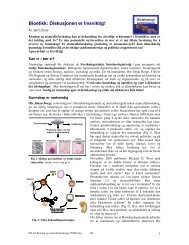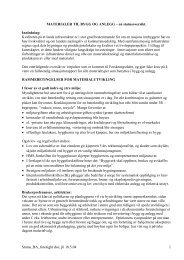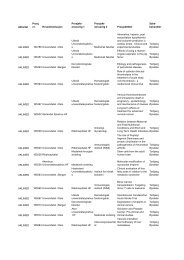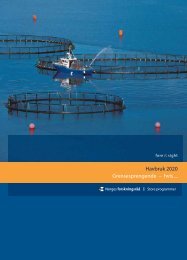A Revolution in R&D
A Revolution in R&D
A Revolution in R&D
Create successful ePaper yourself
Turn your PDF publications into a flip-book with our unique Google optimized e-Paper software.
16<br />
Cellomics are well positioned to exploit the expected<br />
result<strong>in</strong>g demand for screen<strong>in</strong>g resources.<br />
Aurora is a likely w<strong>in</strong>ner <strong>in</strong> the race to resolve chemical<br />
genomics-related bottlenecks, s<strong>in</strong>ce it boasts<br />
some of the most advanced screen<strong>in</strong>g and assay<br />
technologies <strong>in</strong> the <strong>in</strong>dustry. It has an unusual bus<strong>in</strong>ess<br />
model, <strong>in</strong> that it provides tools and discovery<br />
services but does not engage <strong>in</strong> any drug discovery<br />
of its own.<br />
* * *<br />
So much for the imm<strong>in</strong>ent efficiency sav<strong>in</strong>gs across<br />
the R&D value cha<strong>in</strong>. They are hardly the end of<br />
TECHNOLOGIES IN WAITING—OTHER TECHNOLOGIES EXAMINED,<br />
BUT OMITTED FROM OUR REPORT<br />
In this report we have focused on the technologies<br />
and approaches that are hav<strong>in</strong>g the greatest impact<br />
on R&D economics today. Several other excit<strong>in</strong>g advances<br />
appear likely to make a comparable impact<br />
beyond the next three to five years (too far ahead for<br />
<strong>in</strong>clusion <strong>in</strong> our analysis for this report), <strong>in</strong> particular,<br />
the use of proteomics <strong>in</strong> target identification,<br />
conditional gene <strong>in</strong>hibition <strong>in</strong> target validation, and<br />
<strong>in</strong>dustrialized structural biology <strong>in</strong> screen<strong>in</strong>g and<br />
drug design.<br />
Proteomics is the study of prote<strong>in</strong> expression and<br />
prote<strong>in</strong>-prote<strong>in</strong> <strong>in</strong>teractions. Its aim is an understand<strong>in</strong>g,<br />
and ultimately exploitation, of prote<strong>in</strong> function.<br />
Identify<strong>in</strong>g prote<strong>in</strong>s through sequence or structure<br />
homology has recently become much more efficient,<br />
thanks to bio<strong>in</strong>formatics’ role <strong>in</strong> analyz<strong>in</strong>g largescale<br />
experiments. One example of a genomics company<br />
apply<strong>in</strong>g proteomics is Oxford Glycosciences,<br />
which is engaged <strong>in</strong> identify<strong>in</strong>g targets and surrogate<br />
markers, both <strong>in</strong> collaboration with pharmaceutical<br />
companies and <strong>in</strong> an <strong>in</strong>dependent pipel<strong>in</strong>e. But proteomics<br />
is not really <strong>in</strong>dustrialized yet, and has high<br />
hurdles to overcome before it is.<br />
We exam<strong>in</strong>ed the economics of proteomic expression<br />
studies us<strong>in</strong>g two-dimensional gel analysis, followed<br />
the story, of course. Other technological advances<br />
are bound to improve R&D productivity further <strong>in</strong><br />
due course. Important emerg<strong>in</strong>g technologies<br />
<strong>in</strong>clude proteomics, partial target <strong>in</strong>hibition, and<br />
structural biology. (See sidebar, “Technologies <strong>in</strong><br />
Wait<strong>in</strong>g.”)<br />
Improv<strong>in</strong>g Decision Mak<strong>in</strong>g<br />
The economics of R&D h<strong>in</strong>ge on success rates, and<br />
success rates depend largely on a cascade of decisions<br />
that have to be made aga<strong>in</strong> and aga<strong>in</strong>:<br />
whether or not to pursue a target or lead, and if so,<br />
how—to what extent and with what approach.<br />
by identification of <strong>in</strong>terest<strong>in</strong>g prote<strong>in</strong>s through mass<br />
spectrometry.<br />
Under optimal conditions today, this approach has<br />
the potential to save about as much <strong>in</strong> cost as<br />
genomics-based approaches do, though not as much<br />
<strong>in</strong> time (about six months less). As the technology<br />
becomes <strong>in</strong>dustrialized, proteomics could well surpass<br />
genomics-based approaches, but that is still<br />
several years away.<br />
The aim of the second promis<strong>in</strong>g technology we<br />
<strong>in</strong>vestigated, conditional gene <strong>in</strong>hibition, is to overcome<br />
a common problem <strong>in</strong> target validation. Here<br />
is the background. A standard technique for target<br />
validation uses “target knockouts.” The potential target<br />
is removed, or “knocked out,” from an animal at<br />
conception; this results <strong>in</strong> the total <strong>in</strong>hibition of the<br />
target’s function from embryo to adult. The trouble is<br />
that drugs work differently. Very seldom do they<br />
<strong>in</strong>hibit target function fully, and they are taken only<br />
after genes have already fulfilled their developmental<br />
role <strong>in</strong> utero. So the use of target knockouts as a target<br />
validation technique does run the risk of creat<strong>in</strong>g<br />
false negatives (<strong>in</strong> some cases <strong>in</strong>dicated by death,<br />
because of the unnatural disruption of embryonic<br />
development). What is needed <strong>in</strong>stead of total gene



